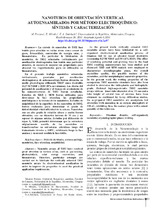Nanotubos de orientación vertical autoensamblados por método electroquímico: síntesis y caracterización

View/
Date
2011xmlui.dri2xhtml.METS-1.0.item-type
article
Citación
Metadata
Show full item recordDocuments PDF
Abstract
La síntesis de nanotubos de TiO2 han tenido gran atención en varias áreas como sensor de gases, fotocatálisis, conversión de energía solar, y biomateriales. En particular la fabricación de nanotubos de TiO2 orientados verticalmente por anodización electroquímica han tenido una particular atención, de manera de mejorar sus propiedades para alcanzar los requerimientos para su utilización en biomateriales. En el presente trabajo nanotubos orientados verticalmente, generados por anodización electroquímica de autoensamblaje fueron obtenidos en medio glicerol/agua utilizando NH4F como electrolito (0.27 M NH4F y H2O 50% en volumen). Los efectos del potencial de anodización y el tiempo de crecimiento de las nanoestructuras de TiO2 fueron estudiadas. Estudios de XRD y SEM fueron utilizados para determinar la fase cristalina, las propiedades morfológicas y la textura de los nanotubos. Estudios de mojabilidad de la superficie de los nanotubos de TiO2, fueron realizadas para determinar el grado de hidrofobicidad e
hidrofilicidad de la misma. Nanotubos con un alto grado de relación altura y ancho fueron
obtenidos, con un diámetro interno de 35 nm y un espesor de algunas micras. Estudios por difracción de rayos X, XRD, permitió determinar que la estructura originalmente amorfa de los nanotubos se transformaban en estructuras cristalinas luego del tratamiento térmico a 550ºC, exhibiendo luego la fase anatasa y en menor medida la fase rutilo. Nanotube arrays of TiO2 have received great attention in various areas, such as gas-sensing, photocatalysis, solar energy conversion, and biomaterials. Therefore, particular attempts are carried out to fabricate the vertically oriented TiO2 nanotube arrays by electrochemical anodization in order to improve its properties to meet the practical application requirements. In the present work, vertically oriented TiO2 nanotube arrays have been fabricated by a selforganized electrochemical anodization process of titanium foil by use of glycerol based electrolyte (containing 0.27M NH4F and 50 vol% H2O). The effect of anodizing potential and growing time in the final TiO2 resulting nanostructure has been studied and discussed. XRD and SEM analysis were employed to characterize crystallographic phase, the overall crystalline quality, the possible texture of the nanotubes, and the morphological nanotube properties. In the present work the wetting properties of the nanoporous TiO2 nanotube structure have also been studied to determine the hidrophobic and hidrophylic grade. Ordered high-aspect-ratio TiO2 nanotube arrays with an inner-tube diameter of ca. 35 nm and a tube height of several tens of microns have been obtained. As confirmed by X-ray diffraction studies, the as-prepared TiO2 nanotubes are amorphous but crystallize with annealing in an oxygen atmosphere at 550 oC, exhibiting then, the anatase phase with a minor quantity of the rutile one.
Keyword/s
Dióxido de titanio
autoensamblaje
nanotubos
fase cristalina
mojabilidad
Titanium dioxide
self-organized
nanotube
crystallographic phase
wetting
Collections
- Vol. 5 No. 2 (2011) [10]
The following license files are associated with this item:

